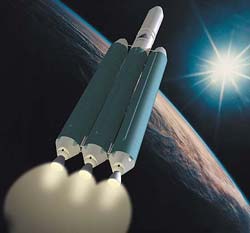The European Space Agency (ESA) has conducted a unique study: developing a self-healing rocket shell.
 |
|
The American Delta 4 rocket (Image: Spacetoday) |
Satellite launch rockets, probes, and spacecraft travel at extremely high speeds in outer space. While in flight, they can be struck by small meteorites and space debris orbiting Earth, leading to punctured shells or damage to critical components of the rocket. To address this costly and sometimes irreparable issue, the European Space Agency (ESA) has undertaken a unique study: developing a rocket shell capable of self-healing.
The European Space Research and Technology Centre (ESTEC) of ESA, headquartered in Noordwijk, Netherlands, has tasked physicist Christopher Semprimoschnig with establishing a research team to tackle this issue. The central idea is to mimic nature: whenever our body is injured (cuts, scrapes, etc.), blood coagulates to form a temporary protective layer, allowing the underlying tissue to heal the wound. Semprimoschnig explains, “When we get injured, we don’t need glue; our body does the job itself.”
In the UK, the aerospace engineering department at the University of Bristol has begun researching the development of self-healing materials. Ian Bond and Richard Trask—two researchers from the department—recently reported initial research results, indicating that they have designed a self-healing system capable of self-activation and countering various attacks in a space environment.
The technology for creating the new rocket shell primarily involves replacing current fiber types with new hollow glass fiber composites, with an inner diameter of 30 microns (one micron equals 1/1,000 mm). These composites contain various products such as adhesive resins, resins mixed with solids, and resins combined with catalysts.
When the rocket shell is damaged, the aforementioned fibers release chemicals. These substances mix together, sealing the cracks. The product has been tested in vacuum chambers under varied thermal and pressure conditions. The system operates quite effectively.
Researchers are currently continuing this work, enhancing the material’s durability under the most severe conditions. According to ESA, the results obtained are “very serious.” However, Semprimoschnig remains cautious: “Everything is just beginning.” He predicts that it will take another decade for this technology to be perfected and implemented. Once complete, the lifespan of rockets and spacecraft will increase, and the risks in space will decrease.
P. THANH


















































